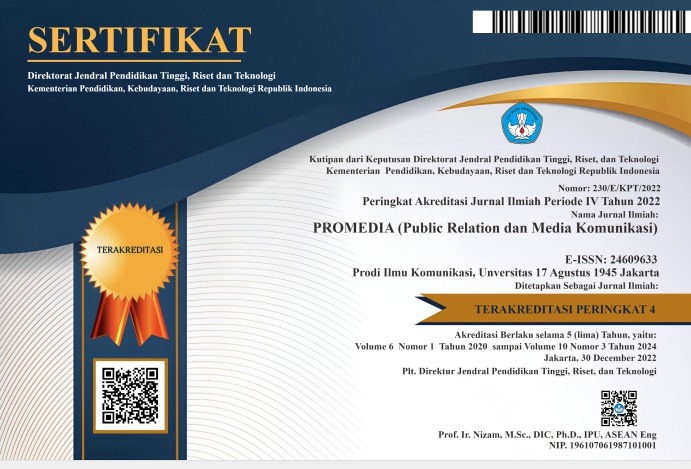HUBUNGAN ANTARA MOTIF KOMUNIKASI INTERPERSONAL DAN KEPUASAN KOMUNIKASI ANTAR PRIBADI GENERASI MILENIAL
Abstract
A stable person is described as a person who is able to establish positive interpersonal relationships. Interpersonal relationships are built through interpersonal communication. The way a person chooses motives in interpersonal communication is believed to be able to influence their satisfaction in communicating. Interpersonal communication motives are a reason for someone to be involved in communication and how someone communicates. 6 motives are the reasons for a person to communicate, namely pleasure, affection, inclusion, escape, relaxation and control (A. M. Rubin, Martin, & Rubin, 1998). Millennial as a generation that stands out in terms of numbers has several uniqueness and weaknesses. One of the salient weaknesses of this generation, which is almost half of Indonesia's population, is the inability to establish interpersonal communication. This inability, of course, affects the satisfaction of their communication and interpersonal relationships.
This research will try to find a relationship between interpersonal communication motives with relationship satisfaction and millennial interpersonal communication in Indonesia. The subjects in this study are the millennial generation in high school in the south Jakarta area, aged 15-19 years. (Howe, 2014). Data was collected using a Motive Interpersonal Communication Scale consisting of 27 items (R. B. Rubin, Perse, & Barbato, 1988) and Communication Satisfaction Scale consisting of 18 items. (Hecht, 1978)
To calculate data from this study using SEM analysis. In addition to seeing the relationship between the two variables, also to find out the dimensions of each research relationship. The results revealed a positive relationship between the selection of interpersonal communication motives with interpersonal communication satisfaction with a CR value of 8.942 and an etimate value of 0.401
Keywords: interpersonal communication satisfaction, millennial generation, communication motives. Relationship satisfaction
Abstrak
Pribadi yang stabil digambarkan sebagai pribadi yang mampu menjalin hubungan interpersonal secara positif. Hubungan interpersonal diantaranya dibangun melalui komunikasi interpersonal. Cara seseorang memilih motif dalam melakukan komunikasi interpersonal, dipercaya mampu mempengaruhi kepuasaan mereka dalam berkomunikasi. Motif komunikasi interpersonal adalah alasan seseorang untuk terlibat dalam komunikasi dan bagaimana seseorang melakukan komunikasi. 6 motif menjadi alasan seseorang melakukan komunikasi, yakni kesenangan, kasih sayang, inklusi, pelarian, relaksasi dan kontrol.(A. M. Rubin, Martin, & Rubin, 1998). Milenial sebagai generasi yang menonjol dari segi jumlah memiliki beberapa keunikan maupun kelemahan. Salah satu kelemahan yang menonjol yang dimiliki oleh generasi yang jumlahnya hanpir separuh dari jumlah penduduk Indonesai ini adalah ketidakmampuan menjalin komunikasi interpersonal. Ketidakmampuan ini,tentu saja mempengaruhi kepuasaan komunikasi dan hubungan interpersonal mereka.
Riset ini akan mencoba mencari hubungan antara motif komunikasi interpersonal dengan kepuasan hubungan dan komunikasi interpersonal milenial di Indonesia. Subyek dalam penelitian ini adalah generasi milenial yang ada Sekolah Menengah Atas di wilayah jakarta selatan yang berumur 15-19 tahun. (Howe, 2014). Data diambil dengan menggunakan Skala Motif komunikasi antar pribadi yang terdiri dari 27 item(R. B. Rubin, Perse, & Barbato, 1988) dan Skala Kepuasan Komunikasi yang terdiri dari 18 item. (Hecht, 1978)
Untuk menghitung data dari penelitian ini menggunakan analisis SEM. Selain untuk melihat hubungan antara kedua variabel, juga untuk mengetahui hubungan perdimensi dari masing-masing skala penelitian. Hasil penelitian mengungkap ada hubungan positif antara pemilihan motif komunikasi antarpribadi dengan kepuasaan komunikasi interpersonal dengan nilai CR= 8,942 dan nilai etimate 0,401
Kata Kunci: kepuasan komunikasi antar pribadi, generasi milenial, motif komunikasi. Kepuasaan hubungan
Full Text:
PDF 171-206 (Bahasa Indonesia)References
Astuti, S. W. (2018). Hubungan antara pemilihan media konvergensi Smartphone dengan Alienasi SOsial Pada Mahasiswa Universitas Mercu buana. Promedia, 4(1), 1–16. Retrieved from http://journal.uta45jakarta.ac.id/index.php/kom/article/view/1103
Beatty, M. J., & Dobos, J. A. (1992). Adult Sons’ Satisfaction with Their Relationships with Fathers and Person-Group (Father) Communication Apprehension. Communication Quarterly, 40(2), 162–176. https://doi.org/10.1080/01463379209369831
Graham, E. E., Barbato, C. A., & Perse, E. M. (1993). The Interpersonal Communication Motives Model. Communication Quarterly, 41(2), 172–186. https://doi.org/10.1080/01463379309369877
Hecht, M. L. (1978). Toward a conceptualization of communication satisfaction. Quarterly Journal of Speech, 64(1), 47–62. https://doi.org/10.1080/00335637809383411
Hecth, M. L., & Marston, P. J. (1987). Communication satisfaction and the temporal development of conversations. Communication Research Reports, 4((2)), 60-65.
Heeman, C. V. (2008). Interpersonal communication motives, satisfaction, and psychological well being in father-young adult daughter relationships. .
Howe, N. (2014). Retrieved from Forbes.Com: https://www.forbes.com/sites/neilhowe/2014/10/27/introducing-the-homeland-generation-part-1-of-2/. Retrieved August 29, 2019, from Forbes Media LLC. website: https://www.forbes.com/sites/neilhowe/2014/10/27/introducing-the-homeland-generation-part-1-of-2/
Miller-Day, M. A. (2004). Communication among grandmothers, mothers, and adult daughters: A qualitative study of maternal relationships. Communication Among Grandmothers, Mothers, and Adult Daughters: A Qualitative Study of Maternal Relationships, (January 2004), 1–266. https://doi.org/10.4324/9781410612120
Rubin, A. M., Martin, M. M., & Rubin, R. B. (1998). Interpersonal communication motives. Communication and Personality: Trait Perspectives, (January 1998), 287–307. Retrieved from c:%5CDocuments and Settings%5CAngel%5CDesktop%5CAngel_Backup%5CEndNote%5CTemplates%5CCancer ACS.dot
Rubin, R. B., Perse, E. M., & Barbato, C. (1988). Conceptualization and Measurement o f Interpersonal Communication Motives. Human Communication Research, 14(4), 602–628.
Rubin, R. B., & Rubin, A. M. (1992). Antecedents of Interpersonal Communication Motivation. Communication Quarterly, 40(3), 305–317. https://doi.org/10.1080/01463379209369845
Sønderby, L. C. (2013). LONELINESS : AN INTEGRATIVE APPROACH. 3(1), 1–29.
Zara, Z. I., & Zara, Z. I. (2008). Interpersonal communication motives satisfaction, and psychological well-being in father-young adult daughter relationships. Guǎnlǐ Xiàndàihuà, 61–64.
DOI: https://doi.org/10.52447/promedia.v5i2.2358
Refbacks
- There are currently no refbacks.
 |  |  |  |
 |  |  |  |
 |  |  |


